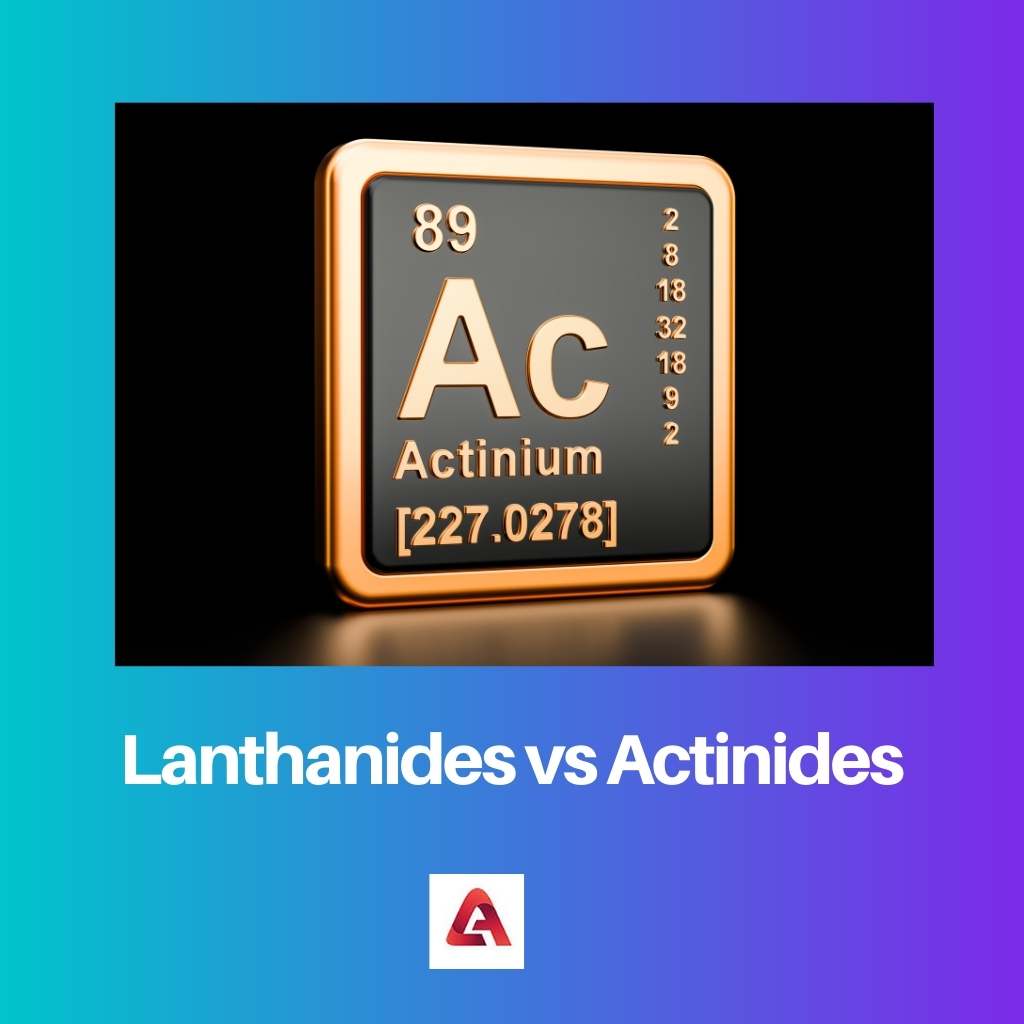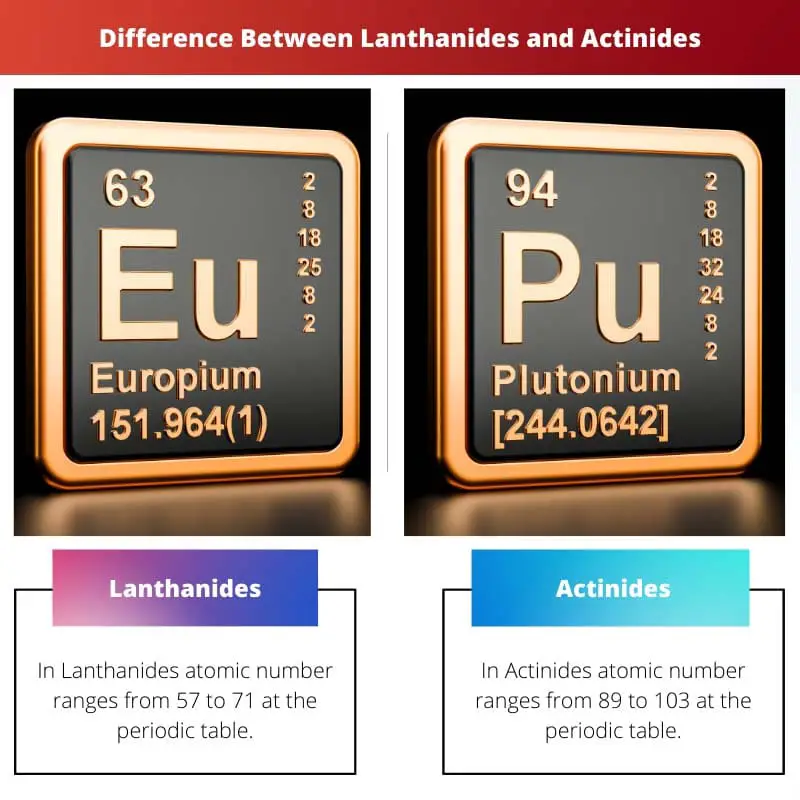We all have studied periodic tables up to Higher Secondary, which was quite interesting to learn here in this article, we have to distinguish the two elements from periodic tables from the chemistry session.
It seems very similar in their chemical property since they both are found in the F block as their valance electron is in F orbit. Moving further visual differences are elaborated on below.
Key Takeaways
- Lanthanides are a series of 15 metallic elements with atomic numbers 57-71, located in the f-block of the periodic table.
- Actinides are a series of 15 elements with atomic numbers 89-103, also in the f-block, and include both naturally occurring and synthetic elements.
- Lanthanides are less reactive and less radioactive than actinides, which contain elements like uranium and plutonium.
Lanthanides vs Actinides
The difference between Lanthanides and Actinides is that Lanthanides have glittery and silvery appearances, and Actinides are found in dark-deep colors. The Binding energy of Lanthanides is comparatively low in comparison with the binding energy of Actinides. The Oxidation state of Lanthanides is +4, whereas Actinides have a +6 oxidation state.

The term Lanthanides refers to the chemical elements present in the Lanthaniod series of the periodic tables since their valance electrons are located in f orbital.
They gave a very low capacity to form complexes, and apart from the +3 oxidation state, they have a +4 oxidation state also. The lanthanide element is quite small in size.
The term Actinides refers to the chemical elements present in the Actinoid series of periodic tables. The elements present in the Actinide series belong to the radioactive category.
They have a very high capacity to form complexes. The majority of them are found in deep colors.
Though it is metal, but has a soft tendency.
Comparison Table
| Parameters of Comparison | Lanthanides | Actinides |
|---|---|---|
| Atomic No. | In Lanthanides atomic number ranges from 57 to 71 at the periodic table. | In Actinides atomic number ranges from 89 to 103 at the periodic table. |
| Elements | No radioactive elements are present in Lanthanides except Promethium. | The radioactive elements are present in Actinides. |
| Oxidation | Lanthanides can have plus-four oxidation states. | Actinides can have plus six oxidation states. |
| Electrons | The position of valance electrons is in the 4f orbital. | The position of valance electrons is in the 5f orbital. |
| Location | A chemical element found in the Lanthanoid series of inner transition is called Lanthanides. | A chemical element found in the Actinoid series of inner transition is called Actinides. |
What are Lanthanides?
The Lanthanides are present at the bottom of the periodic table of chemistry and are called f-block elements to have 1 to 10 electrons.
They are found to be indulged in the filling of 4f orbital, and their energy to bind the electrons is not much high as compared to 5f orbital as present in Actinides.
They are normally non-radioactive apart from promethium. It forms a very less basic compound.
The Lanthanides series initiates from the series, namely Lanthum, and they are called inner soft series metal. The range of atomic number of Lanthanides ranges from 57 to 71 in the periodic table containing very large types of atoms.
They are metallic elements; therefore oxidization process is held in moist air and has the property to dissolve fast in acids.
The very common oxidization state of Lanthanides is +3, which is similar to Actinides, but it can go up to +4. The molecules form by it are not much complex in nature and are also less basic.
They are electropositive elements as a feature in it. The size of atoms or ions tends to decrease throughout the table in lanthanides.
They have different capacities to form a transition series which is first in order.
What are Actinides?
The Actinides are present at the bottom of the chemistry periodic table with radioactive elements. They constitute the second transition in the inner series.
Eventually, the compound formed by Actinides is highly basic. Bright colors are the identity of Actinides, Red and green, as present in U4 and U3.
The Actinide Series starts from alphabet A therefore, they have been given the name of the Actinide series. Due to their unstable nature, all the Actinides are radioactive.
Atomic number series 89 to 103 belong to Actinides, which consist of chemical elements. The most prominent Actinides present on Earth are Uranium and Thorium, Both of them are weakly radioactive.
Actinides realize high energy during radioactive decay. It creates hydroxide and basic oxides. The majority of the complex Actinides are colorful.
In addition to the +3 oxidization state, they show up in the +6 state of oxidization.
Actinides are toxic compounds due to their behaviour activities which are heavy metal and radioactive. All of them are soft and silver Actinides compounds.
High density and plasticity are some of the properties of Actinides. A few Actinides can be cut with the help of a knife this shows their soft characteristics.
Members of the Actinides series tend to generate multiple electrons.
Main Differences Between Lanthanides and Actinides
- Tendency: Lanthanides have a lower capacity to form complexes than Actinides, which have a high tendency.
- Ions: The Ions present in Lanthanides are colorless whereas Ions present in Actinides are bright, for example, U3 and U4.
- Compound: The Compound of Lanthanides is not much basic on the contrary, the compound present in Actinides is more basic.
- Transition: Lanthanides constitute the first transition in the inner series, and Actinides constitute the second transition in the inner series.
- Origin: In Lnathanides, they belong to the sixth period to form 3rd transition series, and In Actinides, they belong to the Seventh period to form the 4th part of the transition series.


The difference between Lanthanides and Actinides is nicely explained in simple terms. I appreciate the detail provided.
I found the comparisons between Lanthanides and Actinides to be very helpful; very detailed and well-organized information!
This article is quite impressive. The depth of detail and the comprehensive descriptions are commendable.
This article presents a very interesting and didactic study of the chemical elements from the periodic table. It is quite notable to observe how the Lanthanides and Actinides are similar and yet notably different.
Dear Yanderson, I agree with you, but all the information presented in the article is very important and outstanding to comprehend.
Interesting and informative content, I learned a lot about the differences between Lanthanides and Actinides
Yes, I agree. The article provides comprehensive information on this topic.
The periodic table was always so curious to me. This article is clear and easy to understand. I like it!
Very well written and informative post. I particularly enjoy the detailed comparison table as it helps to effectively point out the unique differences between Lanthanides and Actinides.
This article is an excellent educational resource for anyone interested in the differences between Lanthanides and Actinides.
I found this article to be fascinating and educational. It has broadened my knowledge and understanding of the periodic table.
The content of the post is clear and concise. A remarkable explanation of Lanthanides and Actinides. However, I think the information could have been presented in a more engaging manner.
Morris Matilda, I have to respectfully disagree with you. The scientific nature of the content may not be the most engaging for some readers, but the educational value of the article is indisputable.
Reading this made me wish I had paid more attention to my chemistry classes in school. Very enlightening post!
The article seems to be well researched and the variety of sources adds credibility to the content.